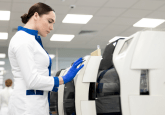Biomarkers for oncology: an interview with Jialu Liu

In this interview, Jialu Liu explains the role of biomarker testing in precision medicine, as well as the major challenges of biomarkers in cancer drug discovery and development.
 Jialu Liu
Jialu Liu
Associate Director and SME for Biomarker Services
Frontage Laboratories (Exton PA, USA)
Dr. Jialu Liu is an Associate Director and Subject Matter Expert for the Biomarker Services team at Frontage Laboratories, providing scientific leadership and contributing to the development of the Global Biomarker Strategy. He works as a liaison between business operations, development and various other departments, and has been involved with communicating and presenting biomarker bioanalysis capabilities to biopharma sponsors. He also leads the biomarker method development team for new LBA method development, transfer and validation projects at Frontage.
Biomarkers are now essential for new targeted therapy trials in oncology. Can you outline the benefits of these pre-treatment tests to patients, as well as the treatment provider?
Cancer biomarkers are substances or processes indicative of the presence of cancer, which can be secreted by a malignancy itself, or as a specific bodily response to the presence of cancer. Biomarkers can be DNA, RNA, protein or metabolomic profiles that are specific to the tumor. A given cancer biomarker may have more than one use and some biomarkers are used in both cancer medicine and drug discovery.
Biomarker testing, which is often the standard of care for patients diagnosed with cancer, can be used by physicians to assess an individual’s risk of developing cancer, diagnose a particular cancer, predict the likelihood that a given therapy will work for a specific patient, monitor a disease’s progression to determine if a therapy is working, determine an individual’s risk of cancer recurrence, etc.
In addition to their uses in cancer medicine, biomarkers are also routinely used in cancer drug discovery. Two major application areas are the development of drug targets and surrogate endpoints in clinical trials. Cancer pharmacodynamic (PD) biomarkers linked to the drugs’ mechanisms of action can often become surrogate endpoints to help with Phase II and III clinical trials.
Is biomarker testing part of personalized/precision medicine?
Biomarker testing is an important part of personalized medicine, also called precision medicine, which is an approach by which medical care is tailored based on the specific genes, proteins and other substances in a person’s body.
In contrast with the traditional trial-and-error method, precision medicine is a field that focuses on differences between people and the potential for these differences to influence medical outcomes. For cancer treatment, precision medicine often uses biomarkers and other tests to select the best possible treatments that are most likely to help, while sparing the patient from receiving treatments that are unlikely to improve their condition.
As a matter of fact, some treatments based on biomarker testing have been around for decades. In recent years, as many of the key changes in genes, proteins and other substances that can induce cancer cells to grow and spread are discovered and better understood, quite a few newer cancer treatments and biomarker tests have been developed successfully.
While progress is being made every day, precision medicine still isn’t part of routine care for people with many types of cancer. This will likely change in the future, as researchers learn more about what makes each type of cancer grow and how this growth can be prevented.
What is the difference between biomarker analytical/laboratory validation and clinical validation?
Validation is “a process to establish that the performance of a test, tool or instrument is acceptable for its intended purpose.” Analytical validation and clinical validation are two distinct aspects of biomarker validation.
Biomarker analytical validation aims to establish the performance characteristics of a biomarker including specificity, selectivity, calibration curve (response function), range (LLOQ to ULOQ), accuracy, precision, carryover, dilution linearity, stability and other relevant performance characteristics following a prespecified protocol. The goal of analytical validation is to reveal a biomarker’s technical performance, not its usefulness. The fit-for-purpose concept should be adopted for the validation, which means that the level of validation should be appropriate for the intended purpose of the study.
In contrast, biomarker clinical validation (or ‘qualification’) provides evidence that a biomarker is linked with a certain biological process and clinical endpoint and aims to reveal the usefulness of the biomarker. In the US, the qualification of biomarkers implies the FDA’s agreement that a particular biomarker and its proposed context of use can be used in drug development and for regulatory submissions without the FDA having to reconfirm its suitability.
What are the major techniques/platforms currently being used to measure soluble protein biomarkers in oncology trials?
Over the years, various protein detection techniques have been developed and their performance can be assessed by various parameters such as sensitivity, specificity, dynamic range, multiplexing capabilities, reproducibility, ease of use and cost.
The most common tool for protein detection is the immunoassay. Currently, the enzyme-linked immunosorbent assay (ELISA) is regarded as the ‘gold standard’ tool for protein detection and quantification. The main advantages of the ELISA include the ability to measure proteins quantitatively with relatively high sensitivity, in the pg/mL range or even lower, and with a wide dynamic range that spans four orders of magnitude. Although ELISAs are rather time-consuming to carry out due to relatively long incubation times and extensive washing, they are quite easy to use. ELISAs are widely used for both clinical diagnostics and basic research. The popular immunoassay platforms nowadays are Meso Scale Discovery™, Quanterix Simoa®, ProteinSimple Ella™, and so on.
Mass-spectrometry (MS)-based proteomic analysis is a powerful approach for discovering new disease biomarkers. Conventional tandem MS digests proteins into peptides, and these peptides can then be used to derive the sequence of the original protein molecule. This strategy, known as ‘bottom-up’ proteomics, provides invaluable information about proteins present in complex samples. Another strategy that may overcome this challenge is the ‘top-down’ approach, in which whole, intact proteins are identified directly using tandem MS. This approach enables the analysis of different types of proteins; however, analyzing low-abundance proteins remains a challenge and quantification is also difficult.
These techniques have provided a wealth of information on proteins and their function but they may suffer from shortcomings in throughput, multiplexing capabilities, specificity and sensitivity. In recent years, many tools have been developed or further advanced to overcome these challenges, such as direct detection of total protein using enzyme-linked immunosorbent spot (ELISPOT), Western blot, protein microarrays, flow cytometry, proximity ligation assay, proximity extension assay and other nucleic acid-based methods, lateral flow assays, surface plasmon resonance, and optical imaging, for example, immunohistochemistry.
What are the major challenges of biomarkers in cancer drug discovery and development?
The challenges of biomarkers in cancer drug discovery and development are met at different stages and levels. For diseases such as cancer, it is often difficult to identify a specific and sensitive biomarker. We may find that a candidate biomarker is associated not only with cancer but also with other diseases or conditions. If that is the case, the biomarker does not have good specificity. In contrast, people who do have cancer may not always have a candidate biomarker.
Tissue accessibility is another challenge. In cancer, researchers must often take a sample of the cancerous tissue to determine whether a biomarker is present. For solid tumors, sampling the tissue can be more of a challenge. One way to get around the problem of needing multiple tissue samples is to look for biomarkers in easily accessible bodily fluids such as blood or urine, which is termed a liquid biopsy. Sometimes scientific justification behind certain biomarkers cannot be validated, causing future challenges in biomarker validation and qualification. Furthermore, inappropriate interpretation of biomarker measurements and improper connection between a biomarker and a disease must be avoided.
Biomarker development may be associated with additional testing requirements or extended clinical trials, hence a possible increase in development costs. Commercial drug developers are often reluctant to invest upfront into biomarkers and to make biomarker data available in the public domain. Furthermore, biomarker development and qualification are usually resource- and time-intensive. Greater evidence of positive benefit-risk assessment is normally required for qualification than for assessment as part of an individual drug regulatory approval.
Early strategic decisions related to the target population are required for the development of precision medicines to make sure that a smaller subset of eligible patients will still generate sufficient profit. Finally, the regulatory landscape for cancer biomarkers is quite complex and evolves constantly, requiring constant monitoring.
This interview is a part of the Bioanalysis Zone Spotlight feature on biomarker bioanalysis in oncology drug development and personalized medicine. For more expert opinions on this topic, visit our feature homepage
In association with:







